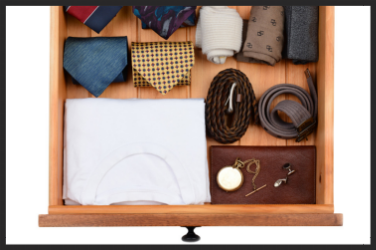Now that we’ve covered the basics of a dress code, it’s time to take it a bit further. If I have to be with people all day, I want to feel comfortable and confident. It's still possible to keep your independent spirit even when following a dress code. Let's make sure you can still be you and express yourself with accessories!
I like my individuality as much as the next person, maybe even more. When I was introduced to a dress code, I felt like I’d become a drone, just another person. But you can demonstrate your personality by accessorizing the basic shirt, bottoms and shoes.
Without fail, I will wear earrings. Sometimes they’re a simple diamond stud. Other times they’re a decorative metallic hoop. I also like to use some earnings to add a little color around my face.
You’ll also find me wearing the watch my husband gave me. Sometimes I’ll even wear a bracelet or two. If you choose a bracelet, just make sure it’s not distracting. Jingling wrist-wear can disrupt your work and take focus away from the important things: The medical encounter between the patient and provider.
(In my next post I’ll go into more detail about jewelry and piercings.)
I always wear a belt with my pants. Mine is a tooled black leather belt with a double silver buckle. It adds a bit of pizzazz without being distracting.
Socks are a fun way to jazz things up as they peek through your pants. They can demonstrate your personality. They might even be a conversation starter. Socks are a good way for guys and ladies to accessorize.
Maybe you’re going to wear a skirt. Choosing tights rather than nylons, or a patterned hosiery, is also fun.
There are an abundance of fun ties out there. Guys, don’t be afraid to make a statement by complementing your top with a great tie. Just make sure it follows the colors of your dress code.
Undershirts can be used to add a bit of style to your outfit. Choose a complementary color to add a pop of personality. Just make sure it doesn’t overtake the primary top. They should be an accessory and not a main piece.
Don’t be afraid to mix up your appearance. Facial hair, make up, hairstyle, glasses and contacts can finish up your signature look.
Now that we’ve talked about some ways to accessorize I want to make one important point: Accessories should have limits. Make sure they’re not a distraction. The interpreter should never be the focus of any encounter. After all, that’s the whole point of establishing a dress code.
Let me know what you do to improve your confidence in your personal appearance.
Related posts:
- Medical Interpreter Dress Code: Integrity at a Glance
- Medical Interpreter Dress Code: What Not to Wear
- ID Badges: Don't Crowd Precious Real Estate
- Medical Interpreter Dress Code: Tops
- Medical Interpreter Dress Code: Bottoms
- Medical Interpreter Dress Code: Shoes
- Medical Interpreter Dress Code: Jewelry, Piercings & Tattoos
- Medical Interpreter Dress Code: Smells and a Closing Thought

